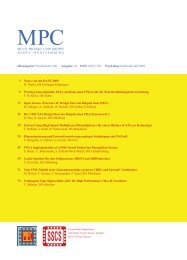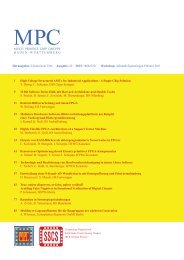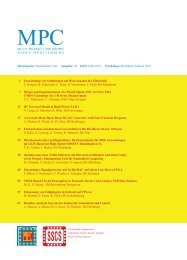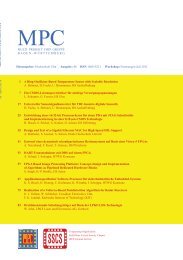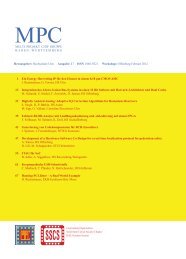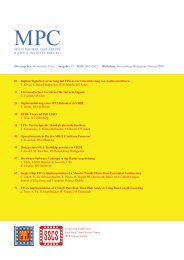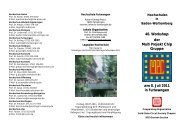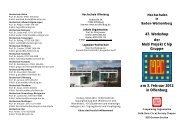[Geben Sie hier die Überschrift ein] - MPC
[Geben Sie hier die Überschrift ein] - MPC
[Geben Sie hier die Überschrift ein] - MPC
- TAGS
- mpc.belwue.de
Sie wollen auch ein ePaper? Erhöhen Sie die Reichweite Ihrer Titel.
YUMPU macht aus Druck-PDFs automatisch weboptimierte ePaper, die Google liebt.
<strong>MPC</strong>-WORKSHOP JULI 2012<br />
Processor Solutions for Smart Mobility<br />
Abstract—The term Smart Mobility denotes the<br />
vision of extensive information dissemination between<br />
mobile entities as well as the environmental<br />
infrastructure with the goal of making mobility<br />
more safe, efficient, environmentally friendly and<br />
comfortable. Therefore, relevant information of<br />
current situations will be deployed and processed<br />
in realtime by all traffic participants. Realizing<br />
future smart mobility applications is in fact directly<br />
and technological inevitably linked to the provision<br />
of sufficient processing power within the individual<br />
sub-systems. Within this paper, we class<br />
smart mobility into the large research field of cyber-physical<br />
systems and discuss requirements and<br />
challenges for realizing smart mobility by means of<br />
appropriate hardware/software architectures. We<br />
present and excert of completed and ongoing research<br />
projects at ITIV in the field of heterogeneous<br />
system architecture development and give an<br />
outlook to worthwhile research directions.<br />
Index terms—Cyber-physical systems.<br />
I. INTRODUCTION<br />
Smart Mobility solutions are essential to meet the<br />
increasing demands on travel and transportation systems.<br />
Green mobility, accident-free driving, support<br />
for elderly people, adaptive route planning to the point<br />
of 4D harmonization, all are catchphrases that can be<br />
allocated to the topic of smart mobility. By integrating<br />
entities from different mobility domains like automotive,<br />
railway or avionics into a spanning communication<br />
network that connects them with each other as<br />
well as the environmental ICT infrastructure, safety<br />
and non-safety relevant information can be disseminated,<br />
which promises improvements in situation<br />
awareness, traffic management and active safety. E.g.<br />
looking at the automotive domain, vehicle-to-vehicle<br />
communication (V2VC) technology promises to be a<br />
next major step towards realization of smart mobility<br />
and thus safer and more efficient road traffic. V2VC<br />
Prof. Dr. Jürgen Becker, becker@kit.edu; Dr. Oliver Sander,<br />
oliver.sander@kit.edu; and Christoph Roth, christoph.roth@kit.edu<br />
are with Karlsruhe Institute of Technology (KIT), Institute for<br />
Information Processing Technology (ITIV), Engesserstraße 5,<br />
D-76131 Karlsruhe, Germany.<br />
Jürgen Becker, Oliver Sander, Christoph Roth<br />
uses so called Vehicular Ad hoc NETworks<br />
(VANETs), that are highly dynamic sensor-actuatornetworks<br />
for information exchange with vehicles as<br />
nodes. Considering the vision of the so called Cyber-<br />
Physical Systems (CPS) this trend of intercommunication<br />
and cross-linkage will continue or rather become<br />
much more intense in future.<br />
In general, due to the increasing complexity of applications<br />
and functions for smart mobility, power and<br />
performance requirements on the underlying hardware/software<br />
system also increase. Feasibility of<br />
smart mobility is in fact directly and technological<br />
inevitably linked to the realizable processing power of<br />
the individual mobile subsystems. One major trend<br />
that can be observed in this context, is the emerging<br />
popularity of embedded multicore systems which is<br />
driven by the need to handle complexity and optimize<br />
performance per watt through integrating evermore<br />
functionality directly into a single device. Especially,<br />
heterogeneous architectures based on reconfigurable<br />
hardware structures can offer an alternative to common<br />
standard solutions with respect to power and<br />
performance. However, the integration of applications<br />
and functions of mixed criticality onto a single multicore<br />
device with respect to certifiability is a nonsolved<br />
problem up to now.<br />
In this contribution, the necessity for novel system<br />
architecture solutions in the context of smart mobility<br />
is outlined. Thereby, different examples of innovative<br />
heterogeneous system architectures that resulted from<br />
research projects conducted at ITIV or that are still<br />
under development at ITIV, are presented. These<br />
illustrate the large solution space in architecture design<br />
and motivate the development of architecture<br />
patterns which allow classifying architectural characteristics<br />
according to their necessity for certain functions.<br />
The remainder of this paper is organized as follows:<br />
Section II classes the term smart mobility into the<br />
larger context of cyber-physical systems. In section III<br />
first, key technologies are identified that are necessary<br />
for realizing CPS and smart mobility. After that, examples<br />
of heterogeneous system architectures in general<br />
as well as in the automotive context are presented.<br />
Also, methods for verification and validation of smart<br />
mobility systems are shortly outlined. Finally, in section<br />
IV we conclude and give an overview on current<br />
and future research directions.<br />
1


![[Geben Sie hier die Überschrift ein] - MPC](https://img.yumpu.com/8654082/4/500x640/geben-sie-hier-die-uberschrift-ein-mpc.jpg)
